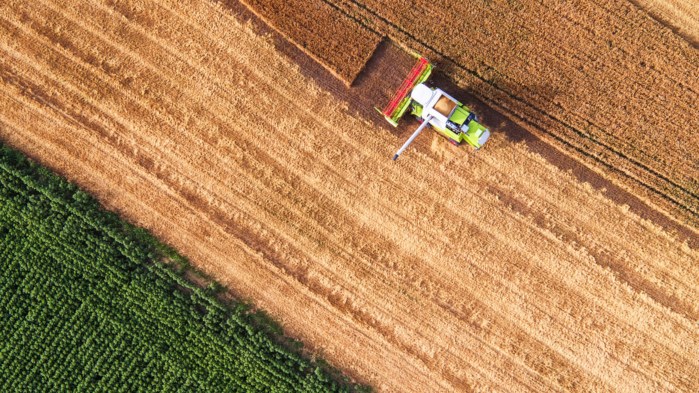Infrastructure helps U.S. farmers compete in global markets while improving their productivity here at home.
On the Surface
America’s surface transportation system includes railways, roads, bridges and waterways. Each play an important role in moving farm products from where they are grown to customers around the world. And broadband Internet – another form of infrastructure – brings market information to farmers faster than ever before.
But: our deteriorating bridges and roadways threaten American agriculture’s dominance by slowing down shipments and making exports more expensive. Meanwhile, 60 percent of farmers say they don’t have enough Internet connectivity to run their businesses.
In his 2019 State of the Union address, President Trump included a call to action to rebuild America’s infrastructure. In July 2020, the U.S. House passed its first infrastructure package since 2016. Will this renewed interest in infrastructure from the White House and on Capitol Hill give U.S. agriculture a reason for optimism during an otherwise challenging year?
The Transportation Cost Edge
In 2018, $139.6 billion in American farm products were exported around the world, supporting more than 1 million jobs around the country, including 691,000 non-farm jobs, according to the U.S. Department of Agriculture. We sell more food, fiber and renewable fuel to world markets than we import, creating a positive agricultural trade balance.
Then the COVID-19 pandemic brought new uncertainties for America’s farmers. Total U.S. agriculture exports in FY 2020 are projected to fall to $136.5 billion due to a rollback in commodities like soybeans, cotton, corn, and wheat. And for soybeans, the trade situation is especially complicated. Aside from the impacts of the ongoing U.S.-China trade war, U.S. soybean exports are falling in part due to increasingly competitive Brazilian exports. Lower transportation costs are part of what gives Brazil’s exporters an edge.

The United States’ historically low cost of transport from farms to export markets has been one of the keys to its competitiveness and historical domination of the global soybean market. But even small differences in transportation costs can give South American soybeans an advantage over U.S. soybeans. Competitors like Brazil are starting to catch up with investment in roads and ports to make their agricultural products more inexpensive – and therefore more attractive to big buyers like China.
Last year, Brazil surpassed the United States as the largest soybean producer in the world while American exports faced duel headwinds of a strong U.S. dollar and Chinese tariffs. Meanwhile, U.S. market share of global soybean trade has actually been declining since the 1990s, in part due to changes in ocean freight rates and the development of Brazil’s transportation infrastructure since 2007.
Getting Food to Market: Roads, Bridges, Dams and Ports
Wherever it’s destined to go in the world, all food starts at the farm. Today in the United States, that often means moving millions of tons of commodities long distances over bumpy roads and structurally deficient bridges, and through crowded ports.
Investment in rural roads, bridges, locks and dams has not kept up with America’s modern agriculture industry. Trade in grains and oilseeds has grown on average between two the three percent per year since 1964. Yet, the United States spends less on transportation infrastructure than during any point since World War II. And infrastructure legislation of the past has often focused on population centers – urban and suburban areas – rather than rural communities whose economies depend on agriculture, and exports.
The situation appears dire once you dig into the numbers. Transportation research organization TRIP’s 2019 Rural Roads Report found that 79 percent of the nation’s bridges that are rated as poor or “structurally deficient” are rural. Altogether, the nation’s rural roads, highways and bridges face a $211 billion backlog in repairs.
Inland waterways move commodities like soybeans to domestic and international markets. But most locks and dams have exceeded their intended 50-year lifespan. The result? In 2017, 49 percent of barges experienced delays – at a cost of nearly $45 million.
In some places, short line railroads are the best or only option for moving agricultural products. Some rural rail lines have closed due to consolidation in the industry. That puts more reliance on trucking to move freight. But more truckers on the road, coupled with aging roadways, means more freight bottlenecks on highways across the United States. In 2016, truck drivers sat in stalled traffic for about 728 million hours at an estimated cost of $50 million.

Rural Broadband is the Next Infrastructure Frontier
Modern infrastructure includes digital connectivity. From following commodity markets to communicating with potential buyers, access to broadband internet is essential for farmers in 2020. Farmers leverage the Internet to improve efficiency, to connect with customers in real-time, and to implement precision technologies that optimize the use of inputs.
Yet, USDA estimates that 80 percent of the 24 million Americans who don’t have access to reliable, affordable high-speed internet are in rural areas. While USDA has ramped up its investment in telecommunications infrastructure, more needs to be done to ensure U.S. farmers remain on the cutting edge of the global economy.
The 2018 report from the Task Force on Agriculture and Rural Prosperity to the White House identified “e-connectivity” as a central pillar for improving the quality of life in rural America. The task force likened the expansion of broadband and precision agriculture to the construction of the U.S. Interstate Highway System of the 1950s, which catapulted productivity and transformed the nation’s economy. Investment in this area will help U.S. farmers compete with other nations like Australia, China and the Netherlands that are already seen as leaders in agriculture technology.

2020 Priorities Aligned
Leaders on both side of the political aisle understand that America’s roads, bridges, and waterways need attention. So why haven’t we done something about it?
Major infrastructure legislation has run into roadblocks at every turn in recent years. While both parties agree there is need for investment, there is little agreement on how to pay for it and what should receive priority for funding. That may change as members of Congress see overlap between infrastructure investment and COVID-19 relief. The agriculture community has been joined by the Western Governors Association, the National Association of Manufacturers and hundreds more organizations in pushing for a long-term infrastructure bill.
The last time that Congress passed a major infrastructure package was the “Fixing America’s Surface Transportation Act” in 2016 – and that expires on September 30, 2020, adding more incentive for Congress to act. In early July 2020, the House passed H.R. 2, the “Moving Forward Act”. Notably, the bill includes grants for rural infrastructure projects and expanding broadband access to under-served areas. But the $1.2 trillion infrastructure plan did not earn bipartisan support.
Where do we go from here? Last summer, the Senate Environment and Public Works Committee advanced its own infrastructure legislation with different priorities. Separately, Senate Commerce Chair Roger Wicker (R-MS) introduced a bill that would accelerate the build out of rural broadband infrastructure. The narrow window for action on infrastructure in 2020 is rapidly closing as we inch closer to the November elections.
Out of Sight, Out of Mind?
If you live in a city, perhaps you haven’t considered the long road that a soybean (or any other farm product) travels on aging roads, bridges, and dams. High speed Internet is something many of us take for granted. So it may be easy to overlook the role that infrastructure plays in helping American farmers find new markets and connecting rural communities with the world.
Renewed investment in roads and waterways, as well as e-connectivity, would make a big impact in rural communities that have been hit hard by the trade war and global pandemic, helping American farmers compete in the global economy.
____________________________________________________________

Sarah Hubbart provides communications strategy, content creation, and social media management for TradeVistas. A native of rural Northern California, Sarah has melded communications and policy throughout her career in Washington, D.C., serving in government affairs, issues management, and coalition building roles in the agricultural sector. She is an alum of California State University, Chico and George Washington University.
This article originally appeared on TradeVistas.org. Republished with permission.








Leave a Reply